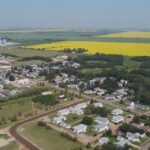The familiar haze of wildfire smoke that has become an unwelcome harbinger of summer for many Canadians is now becoming a global concern as the 2025 wildfire season reveals its unprecedented reach. What once remained largely a Canadian crisis has transformed into an international environmental emergency, with smoke plumes traveling thousands of kilometers across continents, affecting air quality and public health in regions previously untouched by Canada’s seasonal burns.
“What we’re witnessing is truly extraordinary in scope,” says Dr. Helena Moreau, atmospheric scientist at Environment Canada. “The particulate matter from these fires isn’t just creating a local crisis—it’s circling the Northern Hemisphere in patterns we’ve never documented before.”
Satellite imagery from the Canadian Space Agency confirms smoke from British Columbia and Alberta wildfires has reached as far as Western Europe and parts of Northern Africa, triggering air quality alerts in countries with little historical experience managing wildfire smoke exposure. According to World News meteorological data, the transcontinental movement of smoke particles has been facilitated by unusually strong jet stream patterns, themselves likely influenced by ongoing climate change effects.
The unprecedented scale of this season’s fires has already consumed over 6.2 million hectares—an area larger than Nova Scotia—and firefighting resources are stretched beyond capacity across multiple provinces. The Canada News desk reports that federal emergency response coordinators have been forced to request international assistance for the third consecutive year.
Economic impacts are mounting rapidly. Tourism revenue in affected areas has plummeted by 47% according to industry reports, while agricultural losses are expected to exceed $1.8 billion nationwide. The CO24 Business analysis team notes that insurance premiums in high-risk regions have increased by an average of 35% since last year, creating additional financial strain on communities already struggling with recovery efforts.
Health officials across North America and Europe are reporting significant increases in emergency room visits for respiratory complaints. “We’re seeing a 30% rise in asthma-related admissions in regions thousands of kilometers from the actual fires,” notes Dr. James Wilkinson of the International Respiratory Health Alliance. “The most concerning aspect is that many healthcare systems outside Canada weren’t adequately prepared for this type of air quality crisis.”
The political response has been equally dramatic. Parliamentary sessions in Ottawa have been dominated by emergency funding debates, with opposition leaders criticizing the government’s preventative measures as “woefully inadequate.” CO24 Politics analysis indicates this crisis may become a defining issue in upcoming federal elections, particularly as climate adaptation policies face renewed scrutiny.
International diplomatic channels have been activated at unprecedented levels, with Canadian officials engaging in emergency consultations with counterparts across Europe and Asia. The cross-border nature of the crisis has prompted calls for new international frameworks to address transboundary air pollution from natural disasters.
Environmental experts emphasize that the intercontinental spread of wildfire smoke represents a new reality rather than an anomaly. “What we’re experiencing in 2025 is likely to become increasingly common,” warns Dr. Samantha Chen, climate scientist at the University of British Columbia. “The combination of warmer temperatures, changing precipitation patterns, and accumulated forest fuel is creating conditions perfectly suited for these mega-fire events.”
As Canadians face another summer under smoky skies, and international communities experience Canadian wildfire impacts for the first time, the fundamental question becomes unavoidable: are our global environmental policies and disaster response systems equipped for a future where no country remains isolated from the consequences of climate-intensified natural disasters?

























